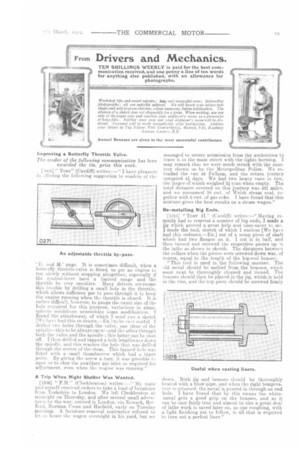From Drivers and Mechanics.
Page 21

If you've noticed an error in this article please click here to report it so we can fix it.
TEN SHILLINGS WEEKLY is paid for the best cornmunication received, and one penny a line of ten words for anything else published, with an allowance for photographs.
a and M.' page. It is sometimes difficult, when a butterfly throttle-valve is fitted, to get an engine to run slowly without stopping altogether, especially if the control-lever have a limited range and the throttle be very sensitive. Many drivers overcome this trouble by drilling a small hole in the throttle, which allows sufficient gas to pass through it to keep the engine running when the throttle is closed. It is rather difficult, however, to gauge the exact size of the hole required for this purpose, variations in atmospheric conditions necessitate some modification. T found the attachment, of which I send you a sketch [We have had this re-drawn—En.] to be cciv useful. I driiled two holes through the valve, one clear of the spindle—this to he always open—and the other through both the valve and the spindle ; this latter can be shut off. I then drilled and tapped a hole lengthways down the spindle, and this reaches the hole that was drilled through the centre of the stem. This tapped hole was fitted with a small thumbscrew which had a taper point. By giving the screw a turn. it was possible ti open or to shut the auxiliary gas-inlet as required for adjustment. even when the engine was running."
A Trip When Night Shelter Was Wanted.
11009] " F.H." (Cleckheaton) writes :--" My mate and myself received orders to take a load of furniture train Yorkshire to London. We left Cleckheaton at midnight on Thursday, and after several small adventures by the way, arrived in London, via Newark, ford, Norman Cross and Hatfield, early on Tuesday morning. A furniture-removal contractor refused to let is house Elle wagon overnight in his yard, but we managed to secure permission from the authorities to leave it in the main street with the lights buriung. I may remark that we were much struck with the courtesy shown us by the Metropolitan Police. We reloaded the van at Fulham, and the return journey occupied 4,1 days. We had two heavy vans in tow, the larger of which weighed 24 tons when empty. The total distance covered on this journey was 421 miles, and we consumed 38 cwt. of Welsh steam coal, togethe.r with 6 cwt. of gas coke. I have found that this mixture gives the best results on a steam wagon."
Re-metalling Big Ends.
[1010] " TOBY II." (Cardiff) writes :—" Having recently had to remetal a number of big ends, I made a jig which proved a great help and time-saver to me. I made the tool, sketch of which I enclose [We have had this redrawn.—En.] out of a scrap piece of shaft which had two flanges on it. I cut it in half, and then turned and screwed the respective pieces up ii the lathe as shown in sketch. The distances between the collars when the pieces were screwed down was, of course, equal to the length of the big-end brasses.
"This tool is used in the following manner. The old metal should be melted from the brasses, which must next be thoroughly cleaned and tinned. The brasses should then he placed in the jig, which is held in the vice, and the top piece should be screwed firmly
down. Both jig and brasses should be thoroughly heated with a blow-pipe, and when the right temperaurn is attained, the metal is poured in through an end hole. I have found that by this means the whitemetal gets a good grip on the brasses, and as it can be cast fairly true and almost to size a great deal of lathe work is saved later on, as one roughing, with a light finishing cut to follow, is all that is required to turn out a perfect






















